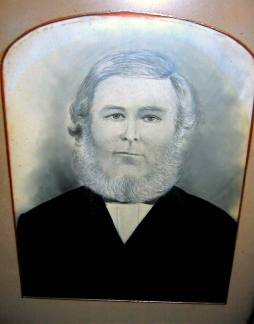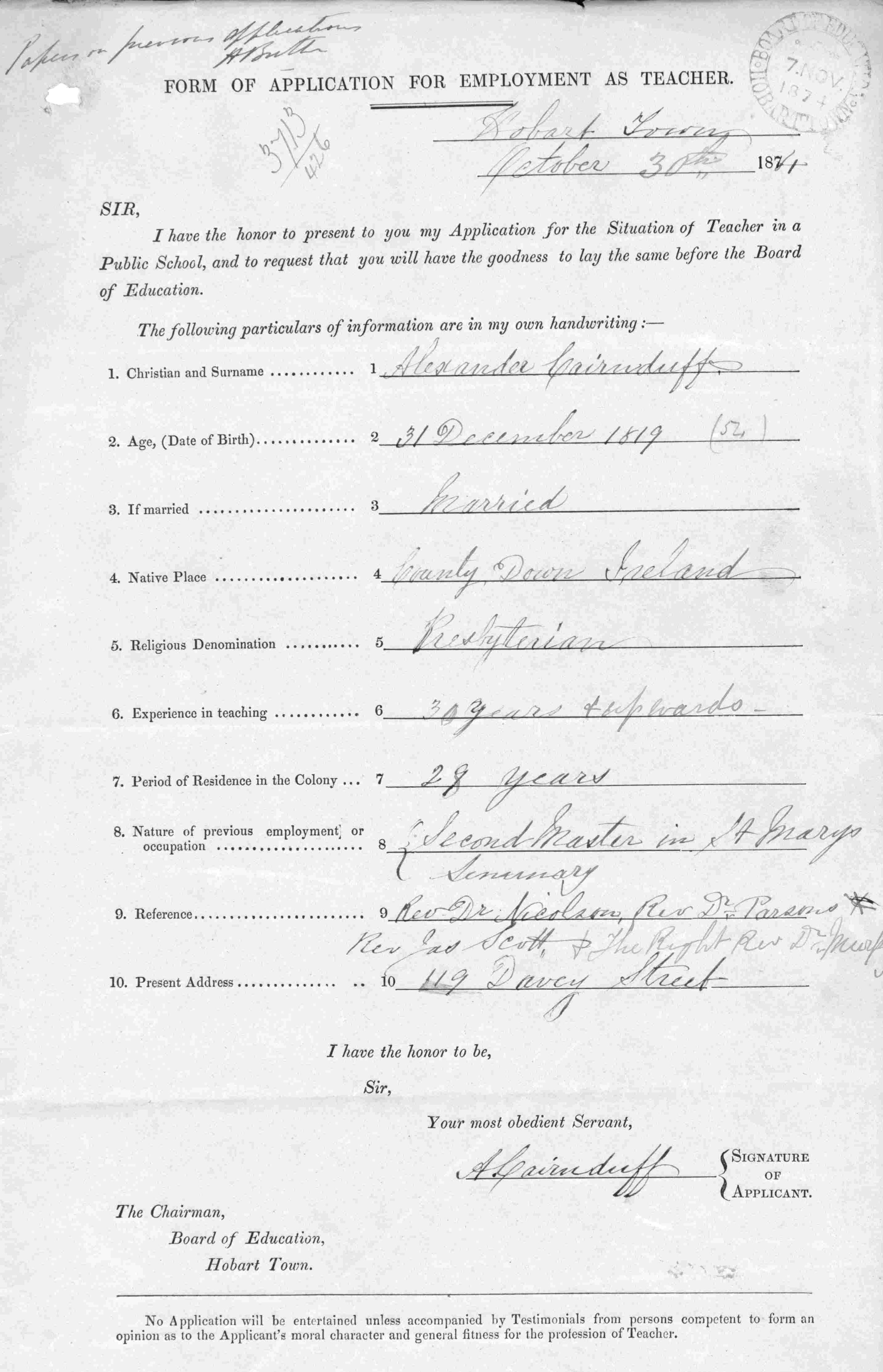 |
Australia Alexander Cairnduff. |
 |
Rev Alexander Cairnduff Australia Born 1815 Northern Ireland - Died 12 September 1880 Sandy Bay Tasmania

|
A descendant of Alexander Cairnduff and Rachel Stevens sent me the above photo of an oil painting in their possesion of Alexander Cairnduff. it is unsigned.The painting was probably painted by the famous Norwegian Artist Knud Geelmuyden Bull, who was employed by Alexander in 1853.
The Information Below was supplied by Heather McNaughton (Cairnduff)- Portarlington, Victoria, Australia.
Alexander Cairnduff was born in County Down on 31st December 1815, he attained The Royal Belfast Academical Institution 1826 -1829 in the college records it is noted that his fathers name was also Alexander and deceased.
|
Surname |
First Name |
Age |
Collegate or Grammer |
Fathers First Name |
Fathers Surname |
Occupation |
Residence |
Presbytery |
Date |
Cairnduff |
Alexander |
25 |
Collegate |
Alexander |
Cairnduff (deceased) |
|
Drumbo Co Down |
|
1826-1829 |
Cairnduff |
John |
|
Collegate |
John |
|
|
Drumbo Co Down |
|
1833-1834 |
|
Below is information on Rev John Downes minister of the Second Boardmills Church co Down confirming a link to Alexander Cairnduff.
He received a call to Hobart, Tasmania, in circumstances highly honourable to himself. A Boardmills man whom Rev John Downes had educated when orphaned influenced a call to that distant field. The call was accompanied by a cheque for £400 to bring him and his family over. Mr. Downes accepted the call, and resigned his congregation on the 7th August 1855.
|
|
Deciding early on a career as a schoolteacher, Alexander gained the Ordinary and extra Certificates of the Ulster Teachers Association. When aged 21 he became private tutor to the family of Robert Patton of Donaghadee, Hoys-town {or hogs Town } in County Down, and remained there until 1838. The Royal Belfast Academical Institute opened 1st Feb 1814 entry age 11 to 18. Alexander returned to Belfast as Master of the Daily school connected with the seaman’s Friends Society. The next year he became librarian in charge of the Belfast Mechanics institute, and at the same time, attending classes in Mathematics, Logic, Belle Letters Hebrew and Elocution at Belfast College {later the Royal Academical Institution}. Presbyterian by upbringing, he was also in the congregation of the Alfred Street Church, around 1838-39. During his last year in Belfast, he was Secretary of the Committee of the Ulster Teachers association.
He left Belfast in June, 1843 to take up an appointment as assistant Schoolmaster at £200 per annum, at Pentonville Prison London, where reforms had lately been adopted through Quaker influence. He also studied at University College, and after 14 months was appointed Religious instructor of a proposed labour Depot in Hobart Town, Van Diemans land. His agreement to this appointment was for an annual salary of £200, together with a residence and rations in the colony for himself and Mrs Cairnduff, commencing from the day of embarkation, either in money or kind.
|
|
Sir George Seymour, An oil painting by W.Howard in The National Maritime Museum in Greenwich. |
On the 9th November 1844, he sailed with his wife Margaret, on board the convict ship Sir George Seymour, being of 580 tons, under the command of master John Young, from Woolwich, as religious instructor to the first draft of "Pentonville exiles" for Van Diemen’s land. A voyage time of 110 days, direct to Hobart town, arriving 26 February, 1845 along with 176 exiles, 91 ticket-of-leave, and 78 pass holders on board. Of these 175 were landed at Geelong, Victoria after their arrival 151 adult males from the ship wrote him a testimonial, thanking him for his treatment during the voyage. Passengers were Dr Hampton, Surgeon Superintendent, Mrs Hampton and son, Captain Thompson 58th and Lieut Drought, 62nd, 30 rank and file 58th Regiment, 5 women and 8 children, Mr and Mrs Boyd and daughter, Mr and Mrs Caunduff, Religious Instructor. On Saturday 8 March it was reported that the number landed here is 169, of which 91 are ticket holders - (appears to be probation passes). The remainder, 174 who are termed 'exiles' leaves this morning for Port Phillip.
The proposed labour depot was not ready, and as per his agreement before leaving England, Lieutent-Governer Wilmot appointed him as religious instructor/school teacher at the penal settlement at Port Arthur where he remained for a year until February 1846. Whilst he was at Port Arthur, they had just started to operate the granary, and to mill corn, but this building was eventually to be converted into the building now known as the penitentiary which the first convicts did not occupy until 1857. In February 1846, he was then moved to the coal mines probation station on Tasman’s peninsular near port Arthur until august when he was once again transferred, to the station at Long point Maria Island. Under the probation system, emphasis was placed on religion as a means of reformation, and religious instructors (who were also to act as school masters to the convicts) were appointed to the most probation gangs.
Humble and humane of purpose, he scorned the futility of instructing convicts by dull mechanical routine, and the governing of them by blind naked strength he used the rules for communicating knowledge which are founded upon the known nature and operations of the human mind, and was guided by them as the only methods whereby the understanding of the pupil is to be improved, and the general culture and development given to all his facilities. His methods attracted the attention of Backhouse and Walker, who used his information to stoke the fires of reform in England.
While at the coal mines, he applied to the Anglican bishop Nixon for ordination. He was refused, because as a religious instructor he came under the control of the convict Chaplin’s department, and Nixon would not ordain anyone outside his jurisdiction, as he has refused others previously. Alexander then asked the Presbyterian authorities to be appointed chaplain to the Presbyterian convicts but the comptroller general of convicts decided that they were too few to warrant it. Having resigned from the convict department, after consultation with the Presbyterian moderator Rev. John Lillie, Alexander was taken on trial as a home missionary. On May 8th 1847, he was sent to do duty at Launceston, Evandale, Nile and Eskvale, in union with the Rev John Anderson and Rev. Robert Russell. The latter had built the Evandale church.
The following year he was appointed to CampbellTown where worship was held in the assembly rooms (now the library), Eskvale upper Macquarie Ross and Mount Seymour. The Eskvale church was erected in 1848 on the Belleview Estate, near the Eskvale homestead. This church was subsequently destroyed by fire, and not rebuilt. Three of the churches were built by voluntary subscription, one of the river Nile, another on the South Esk river and the third at Lincoln on the Macquarie river. He apparently was an excellent horseman and presumable he used this mode of transport to travel between his parishes.
As missionaries were agents of a missionary society, under the immediate superintendence and control of the presbytery, the salaries were derived partly by the funds of the presbytery, and partly from voluntary subscriptions. This arrangement continued until Alexander was move to Hobart Town to assist the Rev James Bell, at St Johns church. The Rev Bell contracted an illness, resulting in paralysis, after his death on Sept 3rd 1852 the services were conducted for nearly a year as " locum tenens" until a replacement a Rev. McLean arrived and was inducted on Oct 10th 1853. Alexander also took classes at the high school.
In 1853, he acquired the Cambridge house academy at 28 Brisbane Street, Hobart Town, which was formerly occupied as a ladies boarding school. He renamed it the Hobart town Academy and opened as a day and boarding school in July, 1853. For a time Alexander employed Knud Geelmuyden Bull the famous Norwegian Artist, as a tutor in the Academy.
Alexander had many testimonials from his former teachers, ministers, past employers and had these printed up into a booklet for prospective clients. They show a great insight into the nature and personality of Alexander, and to trace his movements.
Though contemporises often styled him "reverend" the minutes of two presbyteries prove that he was never actually ordained, but throughout his advertisements for his school, he always referred to himself as "reverend". A public notice was issued in the Hobart Town advertiser 8th December 1855 which reads "established Church of Scotland-the Rev. Mr Cairnduff of Cambridge House Academy, Brisbane Street, has tendered his resignation as a minister, to the presbytery of Van Diemen’s Land at their last meeting, which at Rev Court accepted."
On issues of polity, his sympathies were free, and he became chairman of the southern anti-state aid association. For the next sixteen years, he devoted himself to teaching and the cause of the private schools. When education commissioner’s in 1859-60 suggested that private schools were a systems of fraud and quackery Alexander, in a rare moment of indignation, publicly criticised their report, pointing out that more than half the colony's children were educated in private schools. The additional support the commission gave to the endowed schools, would be argued, place the private schools at a further disadvantage. The truth of this was evinced gradually, as he fought a losing battle for pupils.
|
The Protestant Alliance held successful tea meetings on 28 September and 13 October 1868. These occasions, popular with other contemporary societies, were to prove a staple of Orange activity. A hearty meal, unaccompanied by liquor, preceded an entertainment of songs, recitations and sometimes dancing, punctuated by orations from Protestant ministers and other leaders. One speaker was the well-known Irish educationalist, Alexander Cairnduff, who became a Vice-President of the Tasmanian Alliance and, in 1870 President of the Hearts of Oak Orange Lodge. The latter, though it did not publicly celebrate the 12 July, appeared alongside the Protestant Alliance in Walsh’s Almanac with 46 members in 1870. Neither was cited in 1871.
About 1870 he closed the Hobart Town Academy and moved to St Mary’s seminary, a private school under the patronage of the Roman Catholic bishop, Dr Murphy. In 1875-76, he taught classics and mathematics at Ireland’s collegiate school, Hobart. Surprisingly, this did not injure his standing in the Orange Order.
|
Alexander's application for a teachers position. 1874
|
|
Steamer Tasmania 9th January1862 |
|
Marriage of Alexander Cairnduff to Rachel Stephens
1867 |
|
| |
Marriage of Alexander Cairnduff to Sarah Ann (Gould) Cato 3rd July 1866. |
|
Death of Alexander Cairnduff Boyd born 1855-died 5th July 1859 |
|
Alexander died of cardiac disease in 1880, and was buried at the Queenborough cemetery Sandy Bay, Alexander was married 4 times and produced 7 sons and 2 daughters, his line has increased many times over the years to present day.
Rising Star Tent, I.O.R., No. 3.The Brethren of the Rising Star Tent, I.O.R., No.3, are requested to meet on Wednesday, September15, 1880 at quarter-past 2 o'clock, at their Tent Room,Murray-street, to follow the remains of the late Bro,Alex. Cairnduff to place of interment. The Brethren of Victoria Tent and United Bros.Tent are also respectfully invited to attend.
The original headstone in this cemetery were subsequently removed to make way for the Hutchins School oval. The following inscription was noted: "Sacred to the memory of Alexander Cairnduff died 12 September 1880 Age 65 years.
Below is the actual signature of Alexander 5th December 1846.taken from a letter held in the Archives Office of Tasmania. |
|
......  |
| |
|








